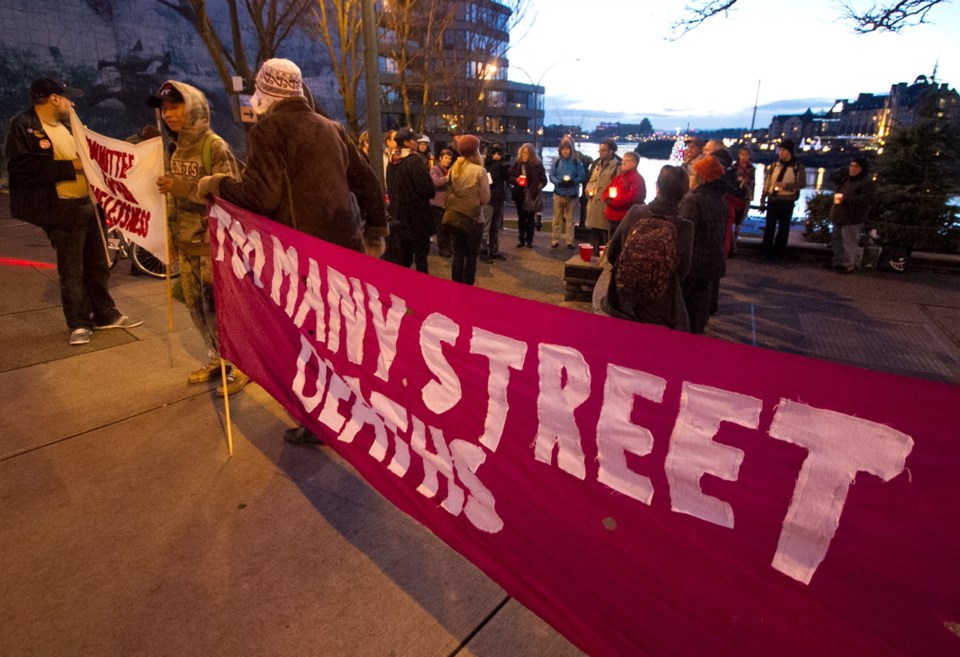One-by-one they filed in, many holding coffee cups, some with last night’s blanket thrown over their shoulders and, as the chairs filled, a stale smell of alcohol and cigarettes permeated the air.
On a grey Victoria morning, in the chapel at Our Place, which has seen more than its share of memorial services this year, members of the street community joined the family of 26-year-old Amy Peters, who hung herself in Beacon Hill Park this fall.
On the service sheet, a photo shows Amy smiling, her blonde, dreadlocked hair held back from her face.
“I don’t know how we got to this point. She was an ordinary teen who came from a good place and there were a lot of people who cared,” said her father Dave Peters, who travelled from Quesnel for the memorial service with his partner, Christine Knapton.
Amy was headstrong and, after graduating from high school, strapped a guitar on her back and hitchhiked around the country for a couple of years, her dad said.
Her family didn’t see any sign of mental illness, just restlessness.
“She was always searching for something and she didn’t find what she wanted. Then she got mixed up in drugs and things,” Peters said. “She couldn’t find what made her happy. If we only knew and could have helped.”
This spring, the family took Amy back to Quesnel, Knapton said.
“She cleaned right up and was doing really well, but she kept saying there was no social life and she wanted to come back to Victoria. She left our house in April,” Knapton said.
At the open microphone, Amy’s street family told stories about the strong-minded young woman, who adored her sometimes-aggressive dog Felony.
“Tears are good to get the pain out,” said Rev. Al Tysick, who conducted the service.
One man, in apparent bewilderment, said he was dating Amy, who seemed “really happy” for the last month.
Groups working with the street community say there have been three times more deaths this year than usual, citing up to 42 people who’ve died.
As the death toll mounted, no common thread has emerged.
“We don’t see any pattern or something that would indicate an epidemic,” said Andrew Wynn-Williams, executive director of the Greater Victoria Coalition to End Homelessness. “It’s a measure of the ongoing, ill-health effects of being homeless.”
Some die in hospital of pneumonia, heart attacks or infections. Others die in rooming houses, some from complications of existing illnesses, or from violence, suicide or drug- and alcohol-related problems. One man burned to death after a portable heater in his makeshift camp caught fire.
Few die on the streets, meaning B.C. Coroner’s Service statistics differ widely from the lists kept by organizations such as Our Place.
The most recent statistics for homeless deaths from the Coroners Service are from 2010. In that year, 34 homeless people’s deaths in B.C. were investigated by the coroner. Only seven of those were on Vancouver Island — a drop from 2008, when 12 homeless deaths were recorded on the Island. There are no comprehensive studies or official statistics regarding the number of street-involved people who die in Greater Victoria or how they die.
One possible reason for the increase in deaths could be that more of the homeless population seems to be older, Wynn-Williams said. “Anecdotally, there are more older people on the street and Cool Aid is trying to get more homes for seniors who have experienced homelessness, but there’s little specific data,” he said.
The definition of “senior” in the homeless community is also fuzzy.
Anyone over 40 is considered old because infection and diseases thrive when people are living without proper shelter, nutrition or medical care, said Don Evans, Our Place executive director.
Marion Little, executive director of PEERS advocacy group for sex workers, said most of the deaths can be directly attributed to poor housing or food and and the effects of poverty on preventable health problems.
Those risks escalate for “survival” sex workers — those who work for food, a place to sleep or drugs. “Survival sex workers are 60 to 100 times more likely to be murdered, mutilated or assaulted than the general public,” Little said.
jlavoie@timescolonist.com
spetrescu@timescolonist.com
